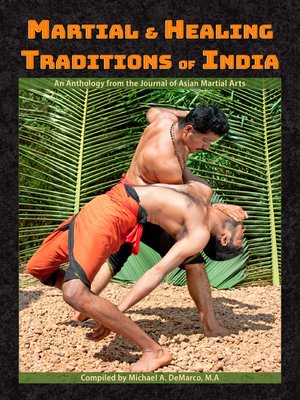Martial & Healing Traditions of India
ebook ∣ An Anthology from the Journal of Asian Martial Arts
By Michael DeMarco

Sign up to save your library
With an OverDrive account, you can save your favorite libraries for at-a-glance information about availability. Find out more about OverDrive accounts.
Find this title in Libby, the library reading app by OverDrive.



Search for a digital library with this title
Title found at these libraries:
| Library Name | Distance |
|---|---|
| Loading... |
During the more than two decades publishing the Journal of Asian Martial Arts, we were fortunate to have Dr. Phillip Zarrilli on our Editorial Board. Internationally known for training actors through an infusion of Asian martial arts and yoga elements, he was a devoted teacher and theatre director/ performer. When he went to India at age 29 to study Kathakali dance, he was sidetracked after becoming captivated by kalaripayattu — the Indian martial art he studied in Kerala State. He eventually became the leading Western scholar who focused on martial arts and healing practice in south India.
Just as we are finishing the preparation of this special anthology for publication, we learn that Dr. Zarrilli passed away on March 9, 2020. This work contains four of Dr. Zarrilli's articles previously published in our journal. These are highly significant for anyone interested in Indian martial traditions and are of great value for comparative studies with other Asian martial arts.
Dr. Zarrilli's material here focuses on the combat arts of kalaripayattu and varma ati, and associated healing arts that encompass massage and herbal modalities. Those familiar with Far Eastern martial arts will find Dr. Zarrilli's thorough presentation of vital spots and energy channels congruent with the theory and practices of acupuncture and the knowledge of energy meridians.
Dr. Sara Schneider shares her experience studying kalaripayattu in Kerala as an American single female in a foreign culture. Her observations as a scholar are insightful. Although not recorded in her writing, it would be equally insightful to obtain the views of how the native guru, his family and students perceived her presence as a foreign academic researcher and martial art practitioner.
Two more chapters broaden the coverage. Khilton Nongmaithem and Dainis Jirgensons present the martial art of Thang-Ta ("sword-spear") as practiced in the northeastern state of Manipur. Their work also hints at the great depth and breadth of Indian martial traditions.
Music and dance are natural companions with martial traditions. By looking at these art forms, Dr. Bandana Mukhopadhyay's chapter brings out some essential elements that accompany the culture of warfare in India.







